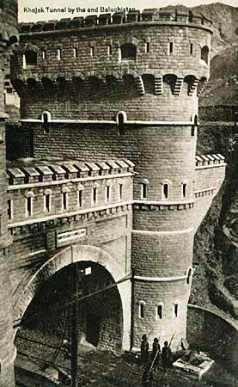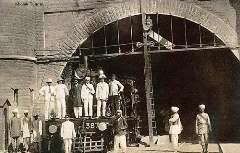Owais Mughal
 Clicking on photos in this article will take you to their source web site as well as larger image sizes.
Clicking on photos in this article will take you to their source web site as well as larger image sizes.
Taking a trip through famous landmarks of Pakistan Railway network has remained a favourite topic at ATP. In the past few months we have travelled through Bolan Pass, Khyber Pass and Chappar Rift. Today we’ll visit yet another marvel of civil and mechanical engineering present on Pakistan’s Railway Network. It is called the Khojak tunnel. Built 115 years ago (September 1891), it was then the fourth longest tunnel in the world and to date it is the longest tunnel in Pakistan.
The photo to the right shows the fortified entrance to Khojak Tunnel. This photo was first published in 1910 by Mullick Brothers of Quetta.
Why was Khojak Tunnel built?
The construction of Sibi-Quetta-Chaman railway line was planned in 1857-58 with the ultimate aim of taking it to Kandahar, and forestalling the threat of Russian offensive in India. At that time there was a recurrent fear of Russian invasion into India through the Bolan pass. Some graves of Russian noblemen from 1850s are found in Sibi-Khost area of Baluchistan which suggests that Russians were already active in this area.
Following photo is also circa 1910 and shows a ceremony going on at the tunnel entrance. The locomotive shown in the photo appears to be an Indian Class L 4-6-0.
 British captured Quetta and its adjoining area in 1876 and formed the Kandahar State Railways with an aim to connect Sukkur (Sindh) with Kandahar (Afghanistan). Work began in 1879. However, by 1888, the idea of building the railway line upto Kandahar was dropped. The project was renamed Chaman Extension Railway. The railway line would now go up to Chaman only. Chaman is the last Pakistani station on Pak-Afghan border.
British captured Quetta and its adjoining area in 1876 and formed the Kandahar State Railways with an aim to connect Sukkur (Sindh) with Kandahar (Afghanistan). Work began in 1879. However, by 1888, the idea of building the railway line upto Kandahar was dropped. The project was renamed Chaman Extension Railway. The railway line would now go up to Chaman only. Chaman is the last Pakistani station on Pak-Afghan border.

 the Finals in three previous showings. Now they have
the Finals in three previous showings. Now they have 
 For many of us the 1980s talk-show Silver Jubilee was the very best of all of
For many of us the 1980s talk-show Silver Jubilee was the very best of all of 






















































